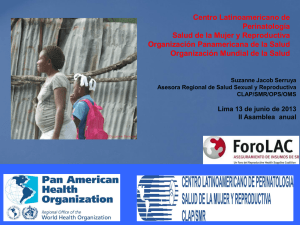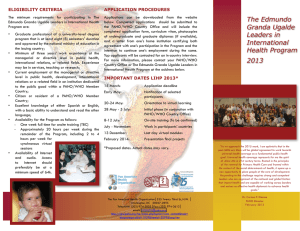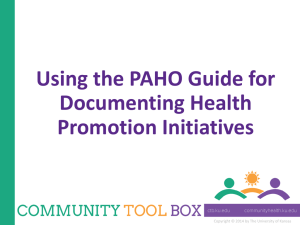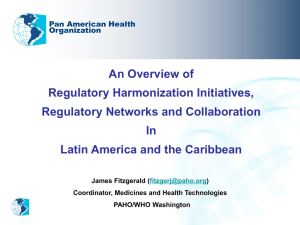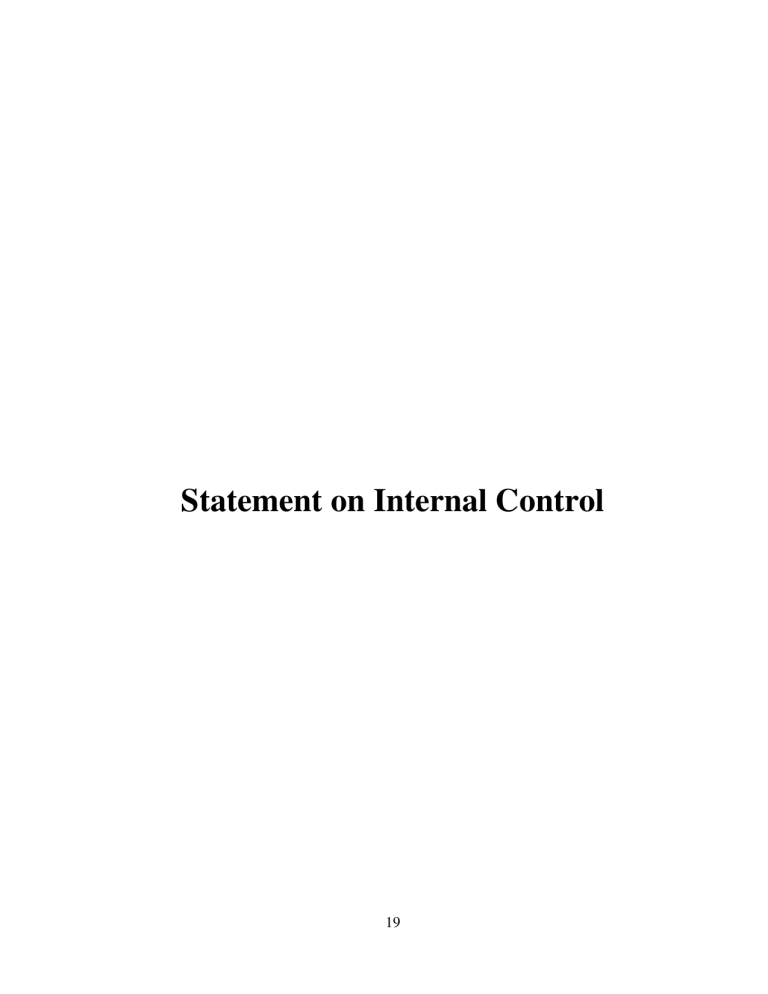
Statement on Internal Control 19 PAN AMERICAN HEALTH ORGANIZATION FINANCIAL REPORT OF THE DIRECTOR and REPORT OF THE EXTERNAL AUDITOR 1 January 2014 – 31 December 2014 Scope of Responsibility As the Director of the Pan American Health Organization (PAHO), I have responsibility for maintaining a sound system of internal control that supports the achievement of PAHO’s mandate and objectives, while safeguarding the funds and assets administered by PAHO, for which I am responsible, in accordance with the responsibilities entrusted to me in the PAHO Constitution, by the Governing Bodies, and in the Financial Regulations of the Organization. Accountability is an integral component of PAHO’s Results Based Management (RBM) framework and, as such, empowers managers to take the necessary steps to achieve their expected results, while requiring the exercise of due diligence in actions and decisions, and compliance with applicable regulations and rules. Delegation of Authority is a prerequisite for the successful implementation of RBM. Good governance is enabled by the appropriate delegation of authority and, as Director, I have approved a Delegation of Authority framework that delineates clear lines of authority over all available resources, both human and financial, and includes the responsibility and accountability of personnel across the Organization. Accountability at PAHO carries with it the obligation to report on the discharge of one’s delegated responsibilities through established mechanisms, including the annual certification of financial information and the evaluation of the status of the implementation of the biennial work plan. The Purpose of the System of Internal Control The system of internal control is designed to manage risk to a reasonable level rather than to eliminate all risk of failure to achieve expected results and strategic objectives. It can therefore only provide reasonable and not absolute assurance of effectiveness. The system of internal control is based on an ongoing process designed to identify and prioritize the risks to the achievement of the Organization’s mandate and objectives, to evaluate the likelihood of those risks being realized and the impact should they be realized, and to manage them efficiently, effectively, and economically. The system of internal control has been in place at PAHO for the financial reporting period 1 January 2014 through 31 December 2014, and up to the date of the approval of the Financial Report of the Director. The foundation for the system of internal control at PAHO lies in the Constitution of the Pan American Health Organization and the Financial Regulations. From this, the Organization has developed and employed additional tools to further inform and guide the control framework, such as the Country Cooperation Strategy (CCS), Staff Rules and Staff Regulations, the E-Manual and the Operations E-Manual for Country Offices and Specialized Centers, Personnel Performance and Evaluation System (PPES), Performance Monitoring and Assessment (PMA), and the Financial Accountability Framework. Capacity to Handle Risk As the Director of PAHO, I have taken note that a system has been created of core and cross-functional teams which have overall responsibility for identifying and assessing risks associated with the implementation of the Program of Work and the overall operations of the Organization. Core teams include the Office of Internal Oversight and Evaluation Services, the Ethics Office, the Office of Legal Counsel, the Country and Sub-regional Coordination Office, the Department of Planning and Budget, the Department of Human Resources Management, and the Department of Financial Resources Management. These core teams are responsible for establishing the control environment, and providing the discipline and structure for the achievement of the primary objectives of the system of internal control. Some examples of key cross-functional teams include the Integrity and Conflict Management System (ICMS), the Asset Protection and Loss Prevention Committee (APLPC), the Property Survey Committee, the PAHO Infrastructure Investment Projects Committee (PIIC), the Investment Committee, the Disaster Task Force, and the Epidemic Alert and Response Task Force. Risk and Control Framework The risk and control framework is developed and implemented by the Governing Bodies and the Pan American Sanitary Bureau (PASB), the Secretariat of the Organization. These organs, as stipulated in Article 3 of the Constitution of PAHO, determine the Organization’s general policies, including financial policy, and review and approve the multi-year strategy and biennial program and budget of the Organization. 20 PAN AMERICAN HEALTH ORGANIZATION FINANCIAL REPORT OF THE DIRECTOR and REPORT OF THE EXTERNAL AUDITOR 1 January 2014 – 31 December 2014 The Secretariat provides regular reporting to the Governing Bodies on the financial, program and budgetary status of the Organization, including an annual report by the External Auditors of PAHO. Furthermore, the Office of Internal Oversight and Evaluation Services (IES) issues an annual report of its activities, with a status of outstanding audit recommendations. The Auditor General also provides the Director with an overall opinion on PAHO’s internal control environment. For the financial reporting period 1 January 2014 through 31 December 2014, the Auditor General has concluded the following: “Based on the findings of its internal audits and its other internal oversight activities in 2014 (and in previous years), and taking into account the findings of other sources of assurance, IES’s overall opinion is that the PASB’s internal control environment provides reasonable assurance over the accuracy and timely recording of transactions, assets and liabilities; the mitigation of risks to the achievement of the Organization’s objectives; and the safeguarding of assets. Absolute assurance is, of course, impossible, owing to inherent limitations for most internal controls. The extent of compliance with internal controls may deteriorate (or improve) over time, and a range of factors (including error, fraud, and changes to operations and procedures) may render some internal controls temporarily inadequate. The Organization’s ever-changing risk profile implies a continuous evolution of internal controls. In particular, the PMIS modernization project is expected to bring a significant degree of automation to internal controls, embedding them into nonmanual processes and thereby reducing risks in the execution of administrative tasks and financial transactions. Any large-scale information system project like the PMIS entails implementation risks, but it also offers an opportunity to replace paper transactions with automated processes and thereby to embed internal controls of a preventive nature in day-to-day operations. The PMIS should thereby promote enhancements to the visibility of transactions and to the efficiency and effectiveness of information flows in the PASB. It should also enhance the prevention (and detection) of exceptions to internal controls. In current institutional governance theory, the concept of “three lines of defense” (based on military or perhaps sporting metaphors) is commonly used to describe the protection of the achievement of Organizational objectives. The “three lines of defense” model has been criticized on the grounds of possible over-simplification, but it provides an interesting way of perceiving institutional governance. The first and second “lines of defense” are provided by management: the first line consists of day-today, risk-mitigating internal control activities, and the second is based on higher-level managerial review activities, including ERM and policy development and compliance monitoring. The “third line of defense”, which operates behind management’s defenses, is the assurance provided by internal auditors (and others). Overall, IES has seen a gradual improvement in the PASB’s three “lines of defense” in recent years. For example, for the first line, the safeguarding of assets has been strengthened through enhanced management approval of transactions for the disposal of fixed assets. For the second line, management has brought clarity to policy matters by consolidating previously-fragmented policy statements in the PAHO/WHO E-manual. For the third line, the ongoing implementation of IES’s recommendations points to management’s commitment to the continuous enhancement of internal controls. As in previous years, IES continues to advise management that, to further strengthen the PASB’s internal control environment, the links of risks to Organizational objectives and to risk-mitigating internal controls needs to be clearer. As discussed above, the development of a more clearly-defined Internal Control Framework and, in parallel, a more focused ERM process that prioritizes key risks and their mitigating measures would define more clearly the connections between the Organization’s objectives, risks, and risk-mitigating internal controls. (3 March 2015)” The Departments of Financial Resources Management (FRM) and Planning and Budget (PBU) submit monthly reports to Executive Management covering the Organization’s current financial position, the likelihood that financial and budgetary plans will be achieved, and the risks attached. These reports are discussed in detail in order that the members of Executive Management have appropriate and comprehensive information necessary to the decision-making process. In addition, a corporate Performance Management Assessment process (PMA) is conducted semi-annually, which involves Executive Management, Entity Managers, and technical staff to assess progress towards the program of work and the Strategic Plan. A fully functional Enterprise Risk Management (ERM) system is critical to control the pace and manner of change in the Organization resulting from the adoption of new technology, the expansion of technical cooperation requirements of Member States, the growth in resources under administration, and adapting to UN transformation. In 2011, PAHO’s Executive Management team approved the conceptual framework of the ERM. PAHO’s approach to risk management is an integral and systematic process not represented by a static risk register, but by a process that is continuously identifying, mitigating, monitoring, and communicating top risk events to the Organization. This type 21 PAN AMERICAN HEALTH ORGANIZATION FINANCIAL REPORT OF THE DIRECTOR and REPORT OF THE EXTERNAL AUDITOR 1 January 2014 – 31 December 2014 of process requires a risk management framework, a risk governance policy, a risk assessment methodology, and Organizationwide training before comprehensive risk assessments can be performed. The completion of the comprehensive risk assessments is the foundation of a factual and accurate risk register. In compliance with the ERM Policy, risk assessments were included as an integral part of the 2014-2015 biennial operational planning process, and the Risk Assessment Methodology was included in the Operational Planning Manual 2014-2015. All PAHO entities were required to identify the risks and mitigation actions for 2014-2015 projects and programs. These registers were included as a planning element of each entity’s biennial work plan. The methodology is also published in the Operations EManual for Country Offices and Specialized Centers. The ERM Program implemented in 2013 and early 2014 had successfully sensitized Executive Management and Managers throughout the Organization to the importance of integrating risk management into planning, budgeting, and evaluation processes. The specific risk register software tool used in this period to record enterprise risks, while well developed and sophisticated, presented a number of drawbacks in meeting PAHO’s need to fully integrate risk management into PAHO’s internal control framework. A new Risk Register tool was developed in-house, meeting the following requirements: aligns risks with PAHO’s Strategic Plan, which is the basis for PAHO’s planning and budgeting system; standardizes risk registry terminology and format; aligns with WHO’s Risk Registry system, facilitating sharing and aggregation of data; aligns with other systems for audit and oversight, among others. The first stage of the tool was completed and a consultant was hired to further its implementation. By 31 December 2014, most entities in headquarters, country offices and centers had been trained in its use. Over 400 risks were identified and recorded in the risk registry, and linked to an outcome of PAHO’s Strategic Plan. The Office of the Director of Administration has recently appointed a new Advisor on Risk Management, which will support the completion of the ERM tool, the review of recorded risks, and the completion of the necessary mitigation and action plans for the 2014-15 biennial workplan. Review of Effectiveness As the Director of the Pan American Health Organization, I have responsibility for reviewing the effectiveness of the system of internal control. My review of the effectiveness of the system of internal control is informed by the work of the Office of Internal Oversight and Evaluation Services (IES), by the senior managers within the Organization who have responsibility for the development and maintenance of the internal control framework, and by the comments made by the External Auditors in their management letters and audit reports. I have been advised on the implications of the result of my review of the effectiveness of the system of internal control by the Auditor General and the Audit Committee. A plan to address identified weaknesses and ensure continuous improvement of the system is in place. The Auditor General reports directly to me. IES undertakes independent and objective assurance and advisory activities, which are designed to improve and add value to the Organization’s operations. Using a systematic, risk-based approach, IES seeks to assist the Organization to achieve its objectives by auditing the effectiveness and efficiency of organizational governance, internal controls, operations, and processes. IES undertakes internal audit assignments, for which very precise objectives are established through an assessment of the relevant risks. On the conclusion of an oversight assignment, IES prepares a detailed report addressed to me, and copied to concerned individuals in the Secretariat. The assignment reports include findings and recommendations to help management address risks, maintain or enhance internal controls, and encourage effective governance. IES systematically follows up on all the recommendations it makes. In addition, IES provides support to evaluation activities throughout the Organization, recording and monitoring all evaluation assignments undertaken across the Organization. The PAHO Audit Committee, which was established pursuant to Resolution CD49.R2, serves in an independent expert advisory capacity to assist the Director and PAHO’s Member States. It provides independent assessment and advice on the operation of the Organization’s financial control and reporting structures, risk management processes, and the adequacy of the Organization’s systems of internal and external controls. The Audit Committee meets twice each year, and met in April and November of 2014. The system of internal control has been in place for the year ending 31 December 2014 and up to the date of the approval of the Financial Report of the Director. However, with the significant growth in the Organization, a number of weaknesses in the system of internal control were identified that have necessitated additional work to be undertaken in order that adequate internal control assurances could be provided. 22 PAN AMERICAN HEALTH ORGANIZATION FINANCIAL REPORT OF THE DIRECTOR and REPORT OF THE EXTERNAL AUDITOR 1 January 2014 – 31 December 2014 Significant Internal Control Issues Actions Taken to Address Issues 1. Corporate Administrative Systems • The implementation of International Public Sector Accounting Standards (IPSAS) has further highlighted the weaknesses in the collection of legacy systems, which required significant modification and manual “work arounds” to meet the requirements of accrual accounting, asset capitalization and depreciation, and annual financial reporting. Furthermore, the systems cannot easily provide the range of integrated management reporting required of a dynamic and growing Organization. After the completion of a business case for PMIS and following one of its recommendations, the PAHO Management Information System (PMIS) team identified, through a competitive procurement process, the best ERP solution and Systems Integrator for PAHO. As a result, two contracts were signed, one with Workday on 30 September 2013, and another with Collaborative Solutions as the Systems Integrator on 30 December 2013. While Workday will be implemented as the core ERP for PAHO covering Human Resources, Payroll, Procurement and Finance, other best of breed solutions will be part of the PMIS implementation for specific functional areas. Tidemark will cover Planning and Budgeting; In-tend will cover Tendering; Cornerstone will be used as PAHO’s Management Learning System; and, a Treasury workstation solution will be identified to provide the Treasury functionality not covered by Workday. It was agreed with the Systems Integrator that implementation will be completed in two phases. The first phase will address Human Resources and Payroll, and went live on 27 January 2015. The second phase will cover Finance and Procurement and will Go Live on 1 January 2016. The implementation of an Enterprise Resource Planning (ERP) system, which would integrate Program Planning, Budget, Finance and Human Resource administration, will result in more accurate and comprehensive real-time information. However, it will also require an increased level of interaction with the ERP by all staff, providing accurate data and extracting necessary information in a decentralized environment. Given that the current systems are not fully integrated, much of this work is centralized at the Regional Headquarters. Therefore, the required competencies to fully realize the effectiveness of an ERP do not exist throughout the Organization. 2. Project Implementation Effective implementation of the Program and Budget is critical to the reputation and sustained growth of the Organization. The balance of Voluntary Contributions commitments that remain unimplemented, as well as the funds returned to donors, has continued to be a concern. A balance of project acceptance and design, rational business practices, policies and procedures, and absorptive capacity of beneficiaries is required to reach optimal project implementation goals. • The full extent of competency requirements will not be known until the ERP is implemented. However, a training plan was developed for Phase 1 based on the competency needs and gaps as identified during the design and test phase of the Implementation Plan for each Phase 1 module and system. The training plan will be continuously updated and enhanced as the various systems processes are implemented including Phase 2. An assessment of competency gaps will be performed post-implementation to address any remaining training requirements. Effective implementation of the Program and Budget is critical to the reputation and sustained growth of the Organization. The balance of Voluntary Contributions commitments that remain unimplemented, as well as the funds returned to donors, has continued to be a concern. A balance of acceptance of grants to fund project, rational business practices, policies and procedures, and absorptive capacity of beneficiaries is required to reach optimal project implementation goals. Over the period 2008-2013, the amount that PAHO has returned to donors has decreased to less than 0.5% of the total Voluntary Contributions funds available to be implemented. PAHO continues to enhance the management controls of 23 PAN AMERICAN HEALTH ORGANIZATION FINANCIAL REPORT OF THE DIRECTOR and REPORT OF THE EXTERNAL AUDITOR 1 January 2014 – 31 December 2014 Significant Internal Control Issues Actions Taken to Address Issues Voluntary Contributions, relying on the Project Implementation Review Reports and the Financial Certification process to ensure optimal implementation of funds entrusted to the Organization. An assessment of the Voluntary Contributions Management Function was conducted in 2012. In 2013, PAHO’s Executive Management adopted a Resource Management Framework (RMF), which will be implemented in 2015. The new RMF defines clear roles for the Resource Mobilization Business Process, to be led by the Department of External Relations, Partnerships and Resource Mobilization (ERP), and the Resource Utilization Business Process, to be led by the Department of Planning and Budget (PBU). The RMF is primarily focused on Voluntary Contributions. It is clear that in the current budgetary situation and the commitment made with the approval of the Strategic Plan 2014-2019, PAHO has to make a special effort to simplify processes, define roles and clear levels of accountability, enhance capacity for effective resource mobilization, and improve the delivery of product/services or objectives that were agreed upon with external partners. In summary, PAHO must develop internal capacity in project management. The Resource Utilization Business Process within the RMF refers to the implementation of resources according with the purposes of the grant within the period of the agreement and includes the following functions related to (a) technical design and budget development, (b) project start-up, (c) monitoring and reporting, (d) adjustments to the implementation plan based in the monitoring of findings, (e) progress reports to donors/partners, (f) project evaluation when is pertinent, (g) project closure; and (h) documentation to identify lessons learned. It is expected that the new Framework will enhance accountability, facilitate the effective management of projects (grants) of all sizes, improve resource coordination among the different offices and departments to meet our strategic goals by standardizing processes, reducing risks, and avoiding duplication of efforts, which will ultimately increase the impact of PAHO Technical Cooperation and the implementation of the Program and Budget. While the RMF is in the early stages of implementation, responsibility for the review of Voluntary Contributions agreements will be transferred to ERP, and PBU will devote its efforts to the simplification of processes in planning and institutionalizing the project management approach in PAHO. 24 PAN AMERICAN HEALTH ORGANIZATION FINANCIAL REPORT OF THE DIRECTOR and REPORT OF THE EXTERNAL AUDITOR 1 January 2014 – 31 December 2014 Significant Internal Control Issues Actions Taken to Address Issues 3. Succession Planning The ongoing retirement of senior managers has the potential to result in a loss of institutional knowledge. In February 2014, EXM approved the Human Resource plans for all entities of the Organization, within the framework of the development of the 2014-2015 biennial work plans. This planning process foresees the timely replacement of positions that remain vacant during this biennium, including managerial positions. These plans are now in the implementation stage. In addition, the Organization contracted a consultant to produce a draft Human Resources Strategy to address succession planning, the right-sizing of the PAHO workforce, the balance among regional/country, technical/administrative, and staff/non-staff within PAHO’s Human Resource Structure. Under this Strategy, several task forces will be formed in 2015 to engage staff members in the elaboration of specific plans to be implemented beginning in the 2016-2017 biennium. The implementation of PAHO’s institutional response to emergencies and disasters (IRED) policy, approved in 2012, continues to strengthen and enhance the ability to respond to emergencies and disasters in the Region. In 2013 and 2014, the Department of Emergency Preparedness and Disaster Relief (PED) provided technical support across the Region, including workshops in Panama and Barbados on PAHO Emergency Response Procedures for Representatives, Administrators and Disaster focal points of 22 country offices. Furthermore, PED was successful in mobilizing resources in response to Member States requests for support in emergency situations, including: support to internally displaced populations in Colombia, dengue in Honduras and Nicaragua, acute respiratory illness in Peru, severe floods in St. Vincent and the Grenadines, St. Lucia and Dominica, drought in Guatemala and Nicaragua, Cholera in Haiti, and severe floods in Bolivia and Paraguay. The Organization has a very conservative Investment Policy overseen by the Investment Committee. The Investment Committee meets in person at least twice each year to review the performance of the investment portfolio and regularly invites experts to these meetings to discuss the various risks in the portfolio, as well as their forecast of the economic environment. The Investment Committee has contracted with four investment managers to manage over $260 million of the $652 million portfolio, thus taking advantage of expertise, economies of scale and opportunities in the market in order to maximize the yield on available resources. 4. Emergency Response PAHO, as the preeminent health agency in the Region of the Americas, must take a leadership role in addressing emergencies. The impact and severity of recent emergencies in the Region have highlighted the need to have a strong, centralized team of specialists to analyze and coordinate response requirements and information. 5. International Economic Environment The prolonged challenging global economic environment presents several risks to the Organization’s ability to fund the Regular Budget: • • • Member States have continued to espouse a policy of zero to minimal nominal growth to the Regular Budget as a result of their own fiscal challenges. The low interest rate environment has reduced the investment income earned and available to supplement the Member States’ Assessed Contributions. Exchange rates in some primary countries have fluctuated significantly during the year, resulting in additional uncertainties regarding the value of the Regular Budget resources locally. 25 The Organization continues to monitor exchange rates in the country offices, and manages the local currency bank balances accordingly. Exchange rate gains and losses are allocated based on the source of the funds. However, as the Regular Budget is denominated in US dollars, fluctuations in local exchange rates will still impact the country office’s “buying power”. Country Offices work closely with the Department of Planning and Budget to address these issues. PAN AMERICAN HEALTH ORGANIZATION FINANCIAL REPORT OF THE DIRECTOR and REPORT OF THE EXTERNAL AUDITOR 1 January 2014 – 31 December 2014 Significant Internal Control Issues Actions Taken to Address Issues 6. Funding of Long-Term Employee Liabilities With the implementation of IPSAS in 2010, the Organization recognized the assets and liabilities of the Organization, resulting in a more transparent picture of the true financial status of the Organization. The long-term liabilities associated with After-Service Health Insurance (ASHI) and Termination and Repatriation Entitlements Plan (TAREP) were recorded on the Statement of Financial Position in 2010, and irrevocable trusts were established for the financial resources available to fund these liabilities (plan assets). While several initiatives have been implemented to provide some funding on both an annual and ad hoc basis, the Organization does not have a comprehensive plan to fully fund the ASHI liability over a determined period of time. Currently, PAHO is assessing a 4% surcharge on staff payroll to provide funding towards the ASHI liability. Revenue from this surcharge totaled $1.8 million in 2014. An additional $1.0 million of investment income earned on the irrevocable trust assets was also credited to the Trust. 7. IT security of PAHO’s Headquarters Network The strength of the security controls in place to access the headquarters IT network presents risks to the integrity of the Organization’s proprietary information. PAHO must consider a plan in order to fund the liability within a determined period of time. The PAHO actuary has provided projections and recommendations to meet this objective based upon a strategy developed by PAHO and WHO that anticipates combining the liabilities and assets of the PAHO/WHO ASHI to achieve efficiencies in meeting funding objectives. It is expected that the funding strategy under consideration will enable PAHO to achieve full funding of the PAHO DBO liability within 5 to 10 years of WHO’s current target of 2037, depending on assumptions about the future evolution of market rates of return and health care cost trends. A proactive Operational Security Assessment was undertaken in January 2014 to assess the PAHO Headquarters network. Access to the network was suspended over a long weekend in order to include both the element of surprise and allow the teams conducting the assessment to perform the work as quickly as possible, while minimizing impact on normal operations. The Organization kept staff informed of the different phases and progress of the Assessment through periodic updates. Two independent external security companies were contracted to work on the Assessment with PAHO. Each company submitted an individual assessment report. These reports include industry best practice-based security remediation recommendations. Based on this information, the Organization prepared a report to the Director on lessons learned. As a result of the Operational Security Assessment that took place in 2014, all of the recommendations made by the two external consultants’ contract have either been completed or are in progress except for the implementation of content filtering/monitoring software which is lagging and presents a risk due to the fact that the firewalls are not blocking new threats. As a result of this Assessment and the subsequent implementation of the various recommendations, the Organization is equipped with a more solid and robust security system to access the IT network of the Organization. 26 PAN AMERICAN HEALTH ORGANIZATION FINANCIAL REPORT OF THE DIRECTOR and REPORT OF THE EXTERNAL AUDITOR 1 January 2014 – 31 December 2014 Conclusion I am confident that as a result of the actions taken to address the significant issues noted above, the system of internal control will continue to be strengthened. Therefore, in my opinion, the Organization’s system of internal control was effective throughout the financial reporting period 1 January 2014 through 31 December 2014, and remains so on the date I sign this statement. ______________________________________ Carissa F. Etienne Director Pan American Health Organization 27
